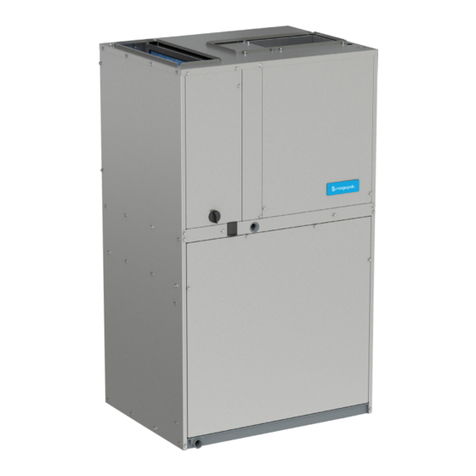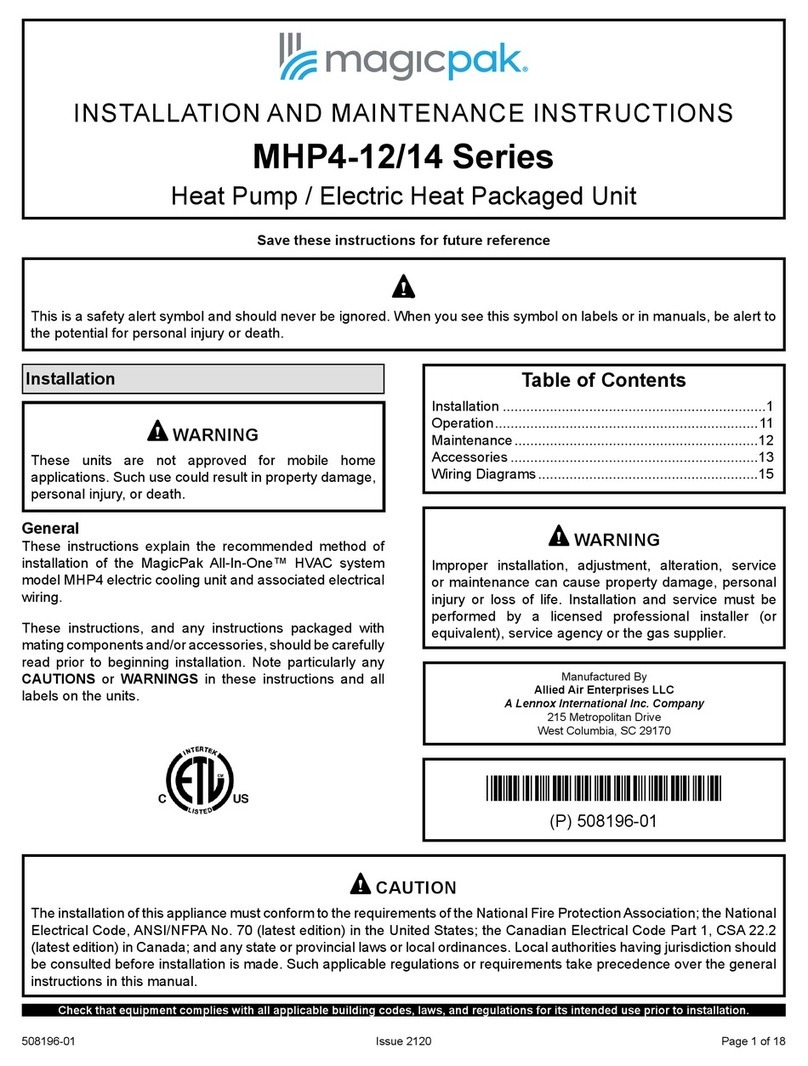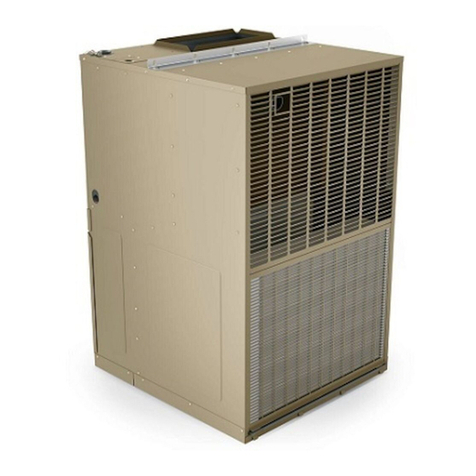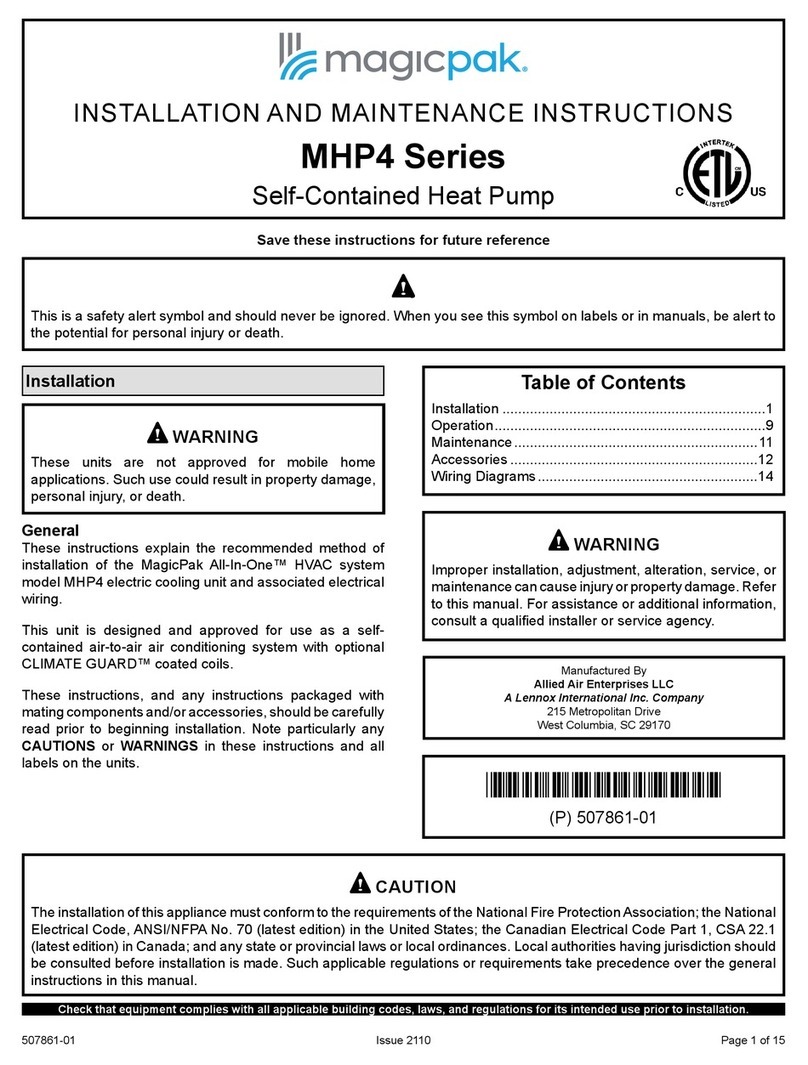
Page 2 of 21 507389-01Issue 1504
install the union and manual shuto valve as well as providing
accessibility for eld wiring. Do not install directly on carpeng,
le, or other combusble material other than wood ooring.
The grille side of the unit may be ush with, or extend beyond, the
face of the exterior wall, but should not be recessed more than
2” from the face of the building and should not be obstructed
with trees, landscape materials, or building structure.
There is no minimum clearance required on locang the unit to
an interior corner of a building.
If the unit is to be enclosed, provisions should be made allowing
access to the indoor side of the unit for changing lters and for
inspecon. At least 29” of unobstructed space should be provided
in front of the indoor side, whether enclosed or not, to permit
removal of the cooling chassis should repairs or inspecon be
required.
If the unit is installed in a residenal garage, it must be located
or protected to avoid physical damage by vehicles. Unit must be
installed so the burners and ignion source are not less than 18”
(457 mm) above the oor. This unit must be installed so that no
electrical components are exposed to water.
This appliance should be installed in a locaon such that the vent
outlet is located in the following manner:
1. Distances to windows that open, building openings, or public
walkways should be consistent with the Naonal Fuel Gas
Code Z223.1 or CAN/CGA-B149.1 & .2.
2. For U.S. installaons, the vent system shall terminate a
minimum horizontal clearance of 4’ from electric meters,
regulators, and relief equipment. For installaons in Canada,
refer to the current CAN/CGA-B149.1 & .2 or with the
authories having local jurisdicon.
3. Flue products will not cause degradation to building
materials.
This furnace design is not listed for installaon in mobile homes,
recreaonal vehicles, or outdoors.
Use of Furnace as a Construcon Heater
Allied Air does not recommended the use of these units as a
construcon heater during any phase of construcon. Very low
return air temperature, harmful vapors and operaon of the unit
with clogged or misplaced lters will damage the unit.
Units may be used for heang of buildings or structures under
construcon, if the following condions are met:
• The Unit must be permanently installed per these installaon
instrucons.
• A room thermostat must control the furnace. The use of xed
jumpers that will provide connuous heang is not allowed.
• The return air duct must be provided and sealed to the
furnace.
Location
The design is cered for indoor installaon only. The interior
porons of the unit may be surrounded by a closet with
clearances to combusble material held to 0” sides, 2” top, and
1” front and plenum. Adequate clearance must be provided to
INSTALLATION
General
These instrucons must be hung on or near the furnace in a
conspicuous place.
The HWC9 V-Series™ units are self-contained, gas-red heang
with electric cooling models. The unit design has been cered by
Intertek Tesng Services for compliance with the latest edion of
the American Naonal Standard – ANSI Z21.47/Naonal Standard
of Canada – CAN/CGA-2.3 for direct vent central furnaces. The
HWC9 models are cered to be in compliance with the latest
edion of A.H.R.I. Standard 390. All models are design cered
for heang operaon when red with natural or propane gas.
These installaon instrucons are intended as a general guide
only, for use by an experienced, qualied contractor.
Inspection
The unit is shipped in one package, completely assembled and
wired. The Evaporator drain tubing is in the cooling compartment
behind the lter access panel. Fings for furnace condensate
drainage are located in the hardware kit bag.
If any damage is found, proper notaon should be made on the
carrier’s freight bill. Damage claims should be led with the
carrier as quickly as possible.
Check the rang plate to conrm heang and cooling capacies.
The unit should be operated only with the type of gas and
electrical supply noted on the rang plate.
IMPORTANT: Remove the chassis hold down shipping bracket
before installaon. These brackets are located on the outdoor
side of the unit below the louver panels.
In the State of Massachuses:
This product must be installed by a licensed Plumber or Gas
Fier. When exible connectors are used, the maximum
length shall not exceed 36”. When lever-type gas shutos
are used, they shall be T-handle type.
WARNING
Install operate and maintain unit in accordance with
manufacturer’s instrucons. The State of California has
determined that this product may contain or produce
chemicals, in very low doses, which may cause serious
illness or death. it may also cause cancer, birth defects or
reproducve harm.
WARNING
































